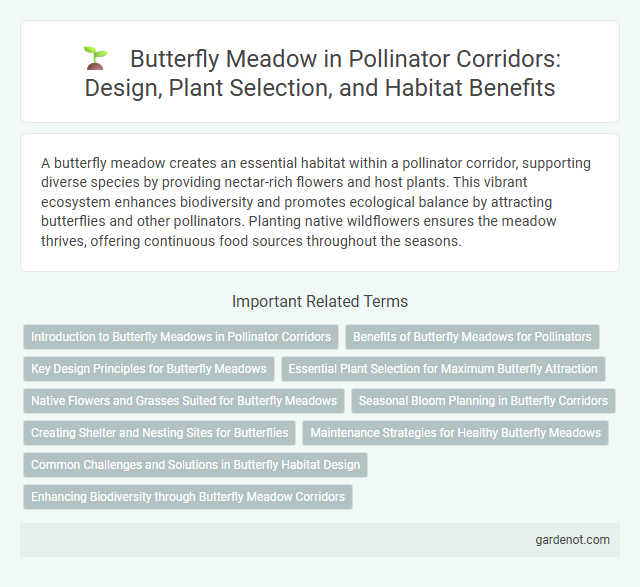A butterfly meadow creates an essential habitat within a pollinator corridor, supporting diverse species by providing nectar-rich flowers and host plants. This vibrant ecosystem enhances biodiversity and promotes ecological balance by attracting butterflies and other pollinators. Planting native wildflowers ensures the meadow thrives, offering continuous food sources throughout the seasons.
Introduction to Butterfly Meadows in Pollinator Corridors
Butterfly meadows within pollinator corridors provide essential habitats rich in native flowering plants, supporting diverse butterfly species by offering nectar sources and breeding grounds. These meadows enhance ecological connectivity, allowing butterflies to migrate, forage, and reproduce effectively across fragmented landscapes. Integrating butterfly meadows into pollinator corridors boosts biodiversity and promotes the sustainability of pollination services crucial for ecosystem health.
Benefits of Butterfly Meadows for Pollinators
Butterfly meadows provide essential habitats rich in native wildflowers, offering abundant nectar and pollen sources that support diverse pollinator species. These meadows enhance pollinator populations by improving food availability and shelter, which boosts their reproductive success and overall ecosystem health. Establishing butterfly meadows within pollinator corridors contributes to increased biodiversity and strengthens pollination services critical for agriculture and natural plant communities.
Key Design Principles for Butterfly Meadows
Butterfly meadows thrive by incorporating diverse native flowering plants that bloom sequentially, ensuring continuous nectar sources throughout the butterfly season. Strategic placement near butterfly habitats and minimizing pesticide use enhance pollinator health and biodiversity. Incorporating varied plant heights and open sunny spaces supports butterfly lifecycles, from egg laying to adult feeding.
Essential Plant Selection for Maximum Butterfly Attraction
Selecting nectar-rich native flowers such as milkweed, coneflowers, and bee balm is essential for creating a butterfly meadow that maximizes butterfly attraction. Incorporating diverse flowering plants that bloom sequentially from spring to fall ensures a continuous food source, supporting multiple butterfly species throughout their life cycles. Prioritize host plants like violets and parsley to provide larvae with critical nourishment, fostering population growth and enhancing pollinator corridor biodiversity.
Native Flowers and Grasses Suited for Butterfly Meadows
Native flowers such as milkweed, coneflowers, and black-eyed Susans provide essential nectar and host plants for butterfly species in pollinator corridors. Grasses like little bluestem and switchgrass create suitable habitat structures that support butterfly larvae and protect them from predators. Incorporating these native plants enhances butterfly population resilience and promotes biodiversity in butterfly meadows.
Seasonal Bloom Planning in Butterfly Corridors
Seasonal bloom planning in butterfly meadows enhances pollinator corridors by ensuring a continuous supply of nectar sources from early spring to late fall. Selecting native wildflowers with staggered blooming periods supports diverse butterfly species and promotes ecosystem resilience. Strategic planting schedules maximize habitat connectivity and contribute to sustaining pollinator populations throughout the growing season.
Creating Shelter and Nesting Sites for Butterflies
Butterfly meadows provide essential shelter and nesting sites by offering diverse native plants that support various butterfly life stages. These habitats create microclimates with ample sunlight and protective cover, crucial for egg laying and larval development. Incorporating host plants like milkweed and nectar sources ensures butterflies have safe, sustainable environments to thrive and reproduce.
Maintenance Strategies for Healthy Butterfly Meadows
Maintaining a healthy butterfly meadow requires regular monitoring of native plant species to ensure optimal bloom diversity and timing, which supports various butterfly life stages. Implementing selective mowing practices, such as mowing late in the season and only cutting a portion of the meadow at a time, preserves habitat and nectar sources. Controlling invasive plants through manual removal or targeted herbicide use prevents competition, fostering a vibrant, pollinator-friendly environment.
Common Challenges and Solutions in Butterfly Habitat Design
Butterfly meadows often face challenges such as habitat fragmentation, limited native plant diversity, and pesticide exposure, which hinder butterfly population growth and biodiversity. Incorporating native nectar-rich plants, creating continuous habitat corridors, and implementing integrated pest management are effective solutions that enhance habitat quality and connectivity. Designing butterfly habitats with diverse plant species and shelter options supports various butterfly life stages, promoting stable and thriving pollinator communities.
Enhancing Biodiversity through Butterfly Meadow Corridors
Butterfly meadow corridors create vital habitats that support diverse pollinator species, boosting overall ecosystem resilience. These corridors facilitate gene flow and migration for butterflies, contributing to population stability and increased plant pollination rates. Incorporating native flowering plants in butterfly meadows significantly enhances local biodiversity and promotes sustainable ecological networks.
Butterfly meadow Infographic

 gardenot.com
gardenot.com